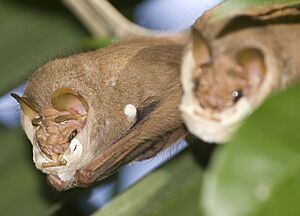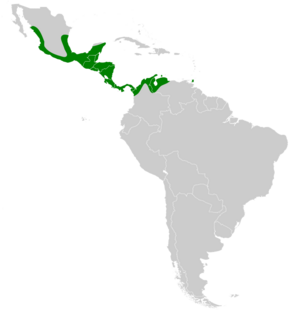Wrinkle-faced bat facts for kids
Quick facts for kids Wrinkle-faced bat |
|
|---|---|
 |
|
| Conservation status | |
| Scientific classification | |
| Genus: |
Centurio
|
| Species: |
senex
|
| Subspecies | |
|
C. senex senex |
|
 |
|
The wrinkle-faced bat (Centurio senex) is a unique type of bat. It belongs to the family Phyllostomidae and is the only known member of its group, called Centurio. You can find this interesting bat in several countries in and around Central America.
Even though it eats fruit, it's not considered a "fruit bat." Instead, it's grouped with leaf-nosed bats, even though it doesn't have a leaf-shaped nose. This bat has a very unusual skull shape. Scientists believe this special skull helps it eat many different kinds of food that other bats might not be able to.
Contents
Meet the Wrinkle-Faced Bat
The wrinkle-faced bat is a medium-sized bat that doesn't have a tail. It usually has fur that is a dull brown or yellowish-brown color. It weighs about 17 grams, which is like weighing a few quarters.
Its face is hairless and covered with many folds of skin. This is why it's called the "wrinkle-faced" bat! These skin folds are much more noticeable on male bats than on females. Male bats also have a special skin mask that they can pull up to cover their face.
The wrinkle-faced bat has pouches inside its mouth. These pouches are handy for storing fruit while it eats.
Two Types of Wrinkle-Faced Bats
There are two main types, or subspecies, of the wrinkle-faced bat:
- C. senex subsp. senex
- C. senex subsp. greenhalli
The C. senex subsp. greenhalli is larger than the more common C. senex subsp. senex. It also has a more rounded braincase and a stronger sagittal crest (a ridge on its skull). Its upper jaw (maxillary toothrow) is also shorter.
Super Strong Bites
These bats have very short and wide skulls. This special skull shape helps them bite with amazing force! They can bite up to 20% harder than other bats of a similar size. In fact, among all leaf-nosed bats, the wrinkle-faced bat can create the strongest bite force for its size.
What Do Wrinkle-Faced Bats Eat?
The wrinkle-faced bat is completely frugivorous, meaning it only eats fruit. However, scientists aren't sure exactly which types of fruit it prefers.
Elizabeth Dumont, a researcher from the University of Massachusetts, thinks that the bat's strong bite is very important. It allows them to survive when soft fruits, like bananas, mangoes, or papayas, are hard to find. With their powerful bite, they can eat tougher fruits that other bats can't.
Some wrinkle-faced bats in Mexico have even been seen eating seeds. This also shows how useful their strong bite force is!
Reproduction and Life Cycle
Female wrinkle-faced bats are thought to have babies more than once a year. They can also get pregnant at different times. Pregnant females have been seen every month from January to August, except for May.
Male bats attract females by giving off a musky smell from their chin area. Recent studies in Costa Rica suggest that these bats use a special mating system called Lek mating. This is where males gather in one area and perform displays to attract females.
Where Do Wrinkle-Faced Bats Live?
The C. senex subsp. senex type of wrinkle-faced bat can be found in many countries:
The C. senex subsp. greenhalli type is only found in Trinidad and Tobago.
Why the Name "Wrinkle-Faced Bat"?
The scientific name for this bat is Centurio senex. This name comes from Latin words. Centurio means "division into hundreds," and senex means "old people."
This name was chosen because people thought the bat's wrinkled face looked like that of a very old person, perhaps even someone who was a hundred years old!


